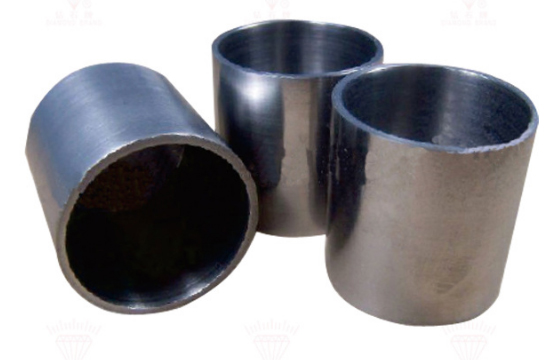molybdenum crucible
Molybdenum crucible has significant mechanical strength and heat
resistance, the corrosion resistance in aggressive industrial
environments. In its properties, molybdenum has remarkably low
coefficients of expansion and a high modulus of elasticity, which
enables you to use it for very responsible products. Molybdenum almost
doubled compared to tungsten more easily, so that the products made of
molybdenum have a greater specific strength (at a temperature of not
more than 1370 ° C).
Chemical properties
Molybdenum reacts with hydrochloric acid, with sulfuric acid only at a
temperature of 80-100 ° C nitric acid, aqua regia dissolves molybdenum
only at a temperature of 100 ° C. Is stable in cold alkaline solutions,
but in hot alkaline solutions molybdenum is slowly destroyed. Impurities
of carbon, oxygen, silicon, aluminum, nitrogen, iron, sulfur and
calcium, phosphorus, which in the technical molebene in hundredths or
thousandths of a fraction of a percent, significantly affect the
properties of molybdenum. Most of these impurities make molybdenum more
fragile. The most harmful of all contaminants is oxygen. If it contains
0.0008-0.004% by volume, low-melting oxides lead to a drastic increase
in its fragility and a reduction in its plastic deformation properties,
especially in the presence of carbon and nitrogen. With an increasing
percentage of oxygen of more than 0.015% molybdenum, pressure is not
processed and becomes brittle.
scope of application
Molybdenum crucibles (milled, chopped or welded) are mainly used in
metallurgy and mechanical engineering.
They are required for the metallization of lanthanum materials, magnetic
material and precious stones and are used both in melting furnaces and
in the manufacture of high-temperature devices.
disadvantage
Almost the only downside is the high cost of molybdenum crucibles, since
Mo is a metal, is related to the elements, rare earth metals and its
pure form is quite heavy.
Production crucibles
Molybdenum crucibles are made from molybdenum high-quality hot-rolled
plates by mechanical processing and pressing.
use When melting rare earth metals, molybdenum crucibles are considered
to be heat-resistant containers for the needs of metallurgy and
mechanical engineering, as well as for the annealing and sintering of
powdered raw materials (non-metals and metals) in the reduction
atmosphere.
.
;
.
molybdenum
Cobalt
Iron
Carbon
Sulfur
Copper
Zinc
Lead
Total Impurities
99.99
<0.00002
0.002
<0.01
0.0002
0.00005
0.00005
0.00002
<0.01
Diam
thickness
length
width
purity
Details

Foil
0.03mm -0.8mm
>3000mm
2mm-150mm
99.99%
Details

sheet
0.03mm-50mm
100mm
100mm
99.99%
Details

wire
0.025mm
-0.05mm
7000-8000m
99.99%
Details

Stab
2.0mm
-150mm
<1000mm
99.99%
Details

powder
50nm- 20μm
99.99%
Details

Pellets
6mm-13mm
99.99%
Details

granules
6mm-13mm
99.99%
Details

Sputter
target
3mm-300mm
O30--2000mm
99.99%
Details

crucible
30ml-50ml
99.9%
Details

mesh
0.05-2mm
hole:0.3X0.6mm, 0.5X1mm
............20X40mm
99.9%
Details
Molybdenum crucible has significant mechanical strength and heat
resistance, the corrosion resistance in aggressive industrial
environments. In its properties, molybdenum has remarkably low
coefficients of expansion and a high modulus of elasticity, which
enables you to use it for very responsible products. Molybdenum almost
doubled compared to tungsten more easily, so that the products made of
molybdenum have a greater specific strength (at a temperature of not
more than 1370 ° C).
Chemical properties
Molybdenum reacts with hydrochloric acid, with sulfuric acid only at a
temperature of 80-100 ° C nitric acid, aqua regia dissolves molybdenum
only at a temperature of 100 ° C. Is stable in cold alkaline solutions,
but in hot alkaline solutions molybdenum is slowly destroyed. Impurities
of carbon, oxygen, silicon, aluminum, nitrogen, iron, sulfur and
calcium, phosphorus, which in the technical molebene in hundredths or
thousandths of a fraction of a percent, significantly affect the
properties of molybdenum. Most of these impurities make molybdenum more
fragile. The most harmful of all contaminants is oxygen. If it contains
0.0008-0.004% by volume, low-melting oxides lead to a drastic increase
in its fragility and a reduction in its plastic deformation properties,
especially in the presence of carbon and nitrogen. With an increasing
percentage of oxygen of more than 0.015% molybdenum, pressure is not
processed and becomes brittle.
scope of application
Molybdenum crucibles (milled, chopped or welded) are mainly used in
metallurgy and mechanical engineering.
They are required for the metallization of lanthanum materials, magnetic
material and precious stones and are used both in melting furnaces and
in the manufacture of high-temperature devices.
disadvantage
Almost the only downside is the high cost of molybdenum crucibles, since
Mo is a metal, is related to the elements, rare earth metals and its
pure form is quite heavy.
Production crucibles
Molybdenum crucibles are made from molybdenum high-quality hot-rolled
plates by mechanical processing and pressing.
use When melting rare earth metals, molybdenum crucibles are considered
to be heat-resistant containers for the needs of metallurgy and
mechanical engineering, as well as for the annealing and sintering of
powdered raw materials (non-metals and metals) in the reduction
atmosphere.
.
;
.
| molybdenum | Cobalt | Iron | Carbon | Sulfur | Copper | Zinc | Lead | Total Impurities | ||
|---|---|---|---|---|---|---|---|---|---|---|
| 99.99 | <0.00002 | 0.002 | <0.01 | 0.0002 | 0.00005 | 0.00005 | 0.00002 | <0.01 |
| Diam | thickness | length | width | purity | Details | ||
|---|---|---|---|---|---|---|---|
 |
Foil | 0.03mm -0.8mm | >3000mm | 2mm-150mm | 99.99% | Details | |
 |
sheet | 0.03mm-50mm | 100mm | 100mm | 99.99% | Details | |
 |
wire | 0.025mm -0.05mm |
7000-8000m | 99.99% | Details | ||
 |
Stab | 2.0mm -150mm |
<1000mm | 99.99% | Details | ||
 |
powder | 50nm- 20μm | 99.99% | Details | |||
 |
Pellets | 6mm-13mm | 99.99% | Details | |||
 |
granules | 6mm-13mm | 99.99% | Details | |||
 |
Sputter target |
3mm-300mm | O30--2000mm | 99.99% | Details | ||
 |
crucible | 30ml-50ml | 99.9% | Details | |||
 |
mesh | 0.05-2mm | hole:0.3X0.6mm, 0.5X1mm ............20X40mm |
99.9% | Details | ||
